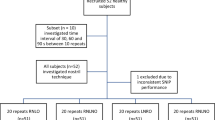Abstract
The sniff nasal inspiratory pressure (SNIP) consists in the measurement of pressure through an occluded nostril during sniffs performed through the controlateral nostril. It is an accurate and noninvasive approximation of esophageal pressure swing during sniff maneuvers. HoweverSNIP can underestimate esophageal pressure swing in subjects with nasal obstruction, patients with chronic obstructive pulmonary disease and severe neuromuscular patients. Nevertheless, since SNIP maneuver has predicted normal values, is noninvasive and is easier to perform than maximal inspiratory pressure (MIP) maneuver, it could be considered as the first simple test to use in order to assess inspiratory muscle weakness. In addition, because it is as reproducible as MIP, it can be suitable to follow inspiratory muscle function in chronic neuromuscular patients. Because, of the important limit of agreement between SNIP and MIP, these two methods are not interchangeable but complementary.
Similar content being viewed by others
References
Black LF, Hyatt RE. Maximal static respiratory pressures in generalized neuromuscular disease. Am Rev Respir Dis 1971;103:641–650.
Black LF, Hyatt RE. Maximal respiratory pressures: Normal values and relationships to age and sex. Am Rev Respir Dis 1969;99:696–702.
Leech J, Ghezzo H, Steven D, Becklake M. Respiratory pressures and function in young adults. Am Rev Respir Dis 1983;128:17–23.
Wilson SH, Cooke NT, Edwards RHT, Spiro SG. Predicted normal values for maximal respiratory pressures in caucasian adults and children. Thorax 1984;39:535–538.
Heritier F, Rahm F, Pasche P, Fitting J-W. Sniff nasal pressure. A noninvasive assessment of inspiratory muscle strength. Am J Resp Crit Care Med 1994;150:1678–1683.
American Thoracic Society/European Respiratory Society. ATS/ERS statement on respiratory muscle testing. Am J Respir Crit Care 2002;166:518–624.
Laporta D, Grassino A. Assessment of transdiaphragmatic pressure in humans. J Appl Physiol 1985;58:1469–1476.
Fitting JW, Paillex R, Hirt L, Aebischer P, Schluep M. Sniff nasal pressure: a sensitive respiratory test to assess progression of amyotrophic lateral sclerosis. Ann Neurol 1999;46:887–893.
Stefanutti D, Fitting JW. Sniff nasal inspiratory pressure. Reference values in Caucasian children. Am J Respir Crit Care Med 1999;159:107–111.
Stefanutti D, Benoist M-R, Scheinmann P, Chaussain M, Fitting JW. Usefulness of sniff nasal pressure in patients with neuromuscular or skeletal disorders. Am J Respir Crit Care Med 2000;162:1507–1511.
Uldry C, Fitting JW. Maximal values of sniff nasal inspiratory pressure in healthy subjects. Thorax 1995;50:371–375.
Fitting JW, Heritier F, Uldry C. [Evaluation of the inspiratory muscle strength using the nasal pressure of the sniff]. Rev Mal Respir 1996;13:479–484.
Polkey MI, Green M, Moxham J. Measurement of respiratory muscle strength. Thorax 1995;50:1131–1135.
Maillard JO, Burdet L, van Melle G, Fitting JW. Reproducibility of twitch mouth pressure, sniff nasal inspiratory pressure, and maximal inspiratory pressure. Eur Respir J 1998;11:901–905.
Uldry C, Janssens JP, de Muralt B, Fitting JW. Sniff nasal inspiratory pressure in patients with chronic obstructive pulmonary disease. Eur Respir J 1997;10:1292–1296.
Hart N, Polkey MI, Sharshar T, et al. Limitations of sniff nasal pressure in patients with severe neuromuscular weakness. J Neurol Neurosurg Psychiatry 2003;74:1685–1687.
Haight J, Cole P. The site and function of the nasal valve. Laryngoscope 1983;93:49–55.
Author information
Authors and Affiliations
Corresponding author
Rights and permissions
About this article
Cite this article
Prigent, H., Lejaille, M., Falaize, L. et al. Assessing inspiratory muscle strength by sniff nasal inspiratory pressure. Neurocrit Care 1, 475–478 (2004). https://doi.org/10.1385/NCC:1:4:475
Issue Date:
DOI: https://doi.org/10.1385/NCC:1:4:475




